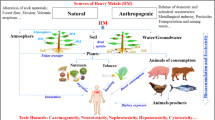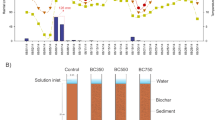Abstract
Background
River and lake sediments constitute complex and difficult analytical samples. On the other hand, sediments play a fundamental role in the distribution of toxic compounds in aquatic systems and in the evaluation of the current state and the course of changes taking place in the environment.
Among elements present in the environment in trace concentrations, but having well-elaborated toxic properties, one of most dangerous is arsenic. The element occurs in the environment in several chemical forms, predominant are inorganic forms of As(V) and As(III), and methylated forms such as monomethylarsonic acid (MMAA) and dimethylarsinic acid (DMAA).
Objectives
Reported herein are experiments, which were undertaken with the aim of examining the dynamics of arsenic sorption in sediments and its dependence on speciation of the element and the pH in the environment. Simultaneously, influence of organic matter content and chemical composition of the sediments on As sorption, were investigated.
Methods
Sediment samples (upper 10 cm layer) were collected from three sites located in the vicinity of Cracow:
-
•
Rudawa river — 37 km long river, flowing mainly through the suburban area;
-
•
Vistula river — heavily contaminated, main Polish river;
-
•
Dobczyce reservoir — artificial reservoir on Raba river, total capacity of 125,000,000 m3, supplying about 60% of drinking water to the city of Cracow.
Using XRD and IR methods, mineral composition of sediments was analysed. Concentrations of iron, manganese, aluminium and arsenic as well as organic matter content in solid samples were analysed.
Sorption experiment
100 g of dry sediment sample was placed in a 400 ml volume glass beaker. 300 ml of arsenic containing solution was poured into the beaker. Every 30 min (total experiment time span equalled 7 to 7.5 hours), 0.5 ml of the suspension’ (the beaker content was constantly mixed) was collected and centrifuged, and the concentration of arsenic was determined in the supernatant.
In the series of experiments, solution contained about 0.05 µg/ml of arsenic in organic (DMAA) and inorganic forms, at different pH values — 3, 5, 7 and 9.
Results and Discussion
Examined sediments of Vistula river and Dobczyce Lake were characterised by relatively high concentrations of arsenic, iron, manganese and aluminium.Rudawa river. At pH 3, the concentration of inorganic As in solution decreased from an initial value of 0.049 µg/ml to 0.012 µg/ml in 7.5 hours time. The same decreasing tendency was found at pH 5 (initial value 0.046 µg/ml, after 7.5 hours - 0.015 µg/ml). Less distinct sorption effects were noted at pH 7 and 9.
Vistula river. At all pH values, a very significant decrease of inorganic As concentration up to 80% of the initial value, as well as a short time of achieving an equilibrium state (1 – 2.5 hours), was found.
Dobczyce lake. Inorganic As was distinctly accumulated in sediments at pH 3 (decrease of As concentration in solution from 0.052 to 0.007 µg/ml after 7.5 hours of the experiment) and at pH 5. At pH 7, about 40% of As was accumulated in sediments (solution As concentration decrease from 0.050 to 0.030). Only 20% of As adsorbed on sediments at pH 9.Very weak accumulation of organic form of As (DMAA) was found in all examined sediments at pH 3 and 5. At higher pH values no sorption was registered.
Conclusions
The following facts were established:
-
•
inorganic form of arsenic was effectively accumulated in all analysed sediments;
-
•
inorganic As sorption in sediments strongly depended on pH — for sediments of Rudawa river and Dobczyce lake, the highest sorption was found at pH 3, and a decrease of accumulated As was noted with an increase of pH (at pH 9, the lowest amount of As was immobilised in sediments); in the case of Vistula river sediments, a reverse tendency was found;
-
•
organic form of arsenic (DMAA) was accumulated only at pH 3 in all sediments and less significantly at pH 5 (Vistula river sediments); no sorption of that form of As was found in the other sediment samples;
-
•
state of equilibrium (no change in inorganic As concentration in liquid medium) was achieved in 1 hour for Vistula river sediments, after about 2 hours for Rudawa river and after about 4 hours for Dobczyce lake sediments.
Recommendations
The presented method of analysis of As sorption in sediments and results visualization (based on a newly defined coefficient) provides a useful tool for the characterization of sorptive properties of sediments and may be used for other compounds as well. Crucial, functional information — how much of a given element may be accumulated in sediments at a certain pH — is obtained without digestion of the sediment sample, in an experiment taking less than one day.
Similar content being viewed by others
References
Belzile N, Tessier A (1990): Interactions between arsenic and iron oxyhydroxides in lacustrine sediments. Geochim Cosmochim Acta 54, 103–109
Bojakowska I (1995): Influence of sewage disposal on heavy metal accumulation in chosen Polish rivers sediments. Instructions and methods of geological surveys. National Geological Institute, No 55 (in Polish)
Bose P, Sharma A (2002): Role of controlling speciation and mobilization of arsenic in subsurface environment. Wat Res 36, 4916–4926
Campos V (2002): Arsenic in groundwater affected by phosphate fertilizers at Sao Paolo, Brazil. Environ Geol (DOI 10.1007/s00254-002-054-0) — published online
Cullen WR, Reimer KJ (1989): Arsenic speciation in environment. Chem Rev 89, 713–764
Demesmay C, Ollé M (1997): Application of microwave digestion to the preparation of sediment samples for arsenic speciation. Fresenius J Anal Chem 357, 1116–1121
Elwaer N, Belzile N (1995): Microwave dissolution of lake sediments and mine tailings and determination of arsenic and selenium by atomic absorption spectrometry. Int J Environ Anal Chem 61, 189–194
Ferguson JF, Gavis J (1972): A review of the arsenic cycle in natural waters. Wat Res 6, 1259–1274
Jain CK, Ali I (2000): Arsenic: occurrence, toxicity and speciation techniques. Wat Res 34 (17) 4304–4312
Kabata-Pendias A, Pendías H (1999): Biogeochemistry of trace elements. Polish Scientific Publishers PWN (in Polish)
Lai Chin-Hsing, Chen Chih-Yu, Wei Bai-Luh, Yeh Shu-Hsing (2002): Cadmium adsorption on goethite-coated sand in the presence of humic acid. Wat Res 36, 4934–4950
Lin Jih-Gaw, Chen Shen-Yi (1998): The relationship between adsorption of heavy metal and organic matter in river sediments. Environ Intern 24 (3) 345–352
Lin Z, Puls RW (2000): Adsorption, desorption and oxidation of arsenic affected by clay minerals and aging process. Environ Geol 39 (7) 753–759
Liu A, Gonzales RD (1999): Adsorption/desorption in a system consisting of humic acid, heavy metals, and clay minerals. J Colloid Interface Sci. 218, 225–232
Manning BA, Goldberg S (1996): Modelling arsenate competitive adsorption on kaolinite, montmorillonite and illite. Clays Clay Miner 44 (5) 609–623
Marshall SJ, House WA, Russell NJ, White GF (1998): Comparative adsorption of natural and commercially available humic acids to river sediments. Colloid Surfaces A: Physicochem Eng Aspects 144, 127–137
Matschullat J (2000): Arsenic in the geosphere — A review. J Sci Tot Environ 249, 297–312
Polyák K, Hlavay J (1999): Environmental mobility of trace metals in sediment collected in the Lake Balaton. Fresenius J Anal Chem 363, 587–593
Pongratz R (1998): Arsenic speciation in environmental samples of contaminated soil. J Sci Tot Environ 224, 133–141
Ruokolainen M, Pantsar-Kallio M, Haapa A, Kairesalo T (2000): Leaching, runoff and speciation of arsenic in a laboratory mesocosm. J Sci Tot Environ 258, 139–147
Song Y, Müller G (1999): Sediment-water interactions in anoxic freshwater sediments: mobility of heavy metals and nutrients. Springer — Lecture Notes in Earth Sciences 81
Smedley PL, Kinniburgh DG (2002): A review of the source, behaviour and distribution of arsenic in natural waters. Appl Geochem 17, 517–568
Vaithiyanathan P, Ramanthan AL, Subramanian V (1993): Transport and distribution of heavy metals in Cauvery river. Water Air Soil Poll 71, 13–28
Wu Chung-Hsin, Lin Cheng-Fan, Ma Hwong-Wen, Hsi Ting-Qwet (2003): Effect of fulvic acid on the sorption of Cu and Pb onto γ-Al2O3. Wat Res 37, 743–752
Xu H, Allard B, Grimvall A (1991): Effects of acidification and natural organic materials on the mobilitv of arsenic in environment. Water Air Soil Poll 57–58, 269–278
Author information
Authors and Affiliations
Corresponding author
Rights and permissions
About this article
Cite this article
Reczynski, W., Posmyk, G. & Nowak, K. Dynamics of arsenic-containing compounds sorption on sediments. J Soils & Sediments 4, 95–100 (2004). https://doi.org/10.1007/BF02991052
Received:
Accepted:
Issue Date:
DOI: https://doi.org/10.1007/BF02991052




